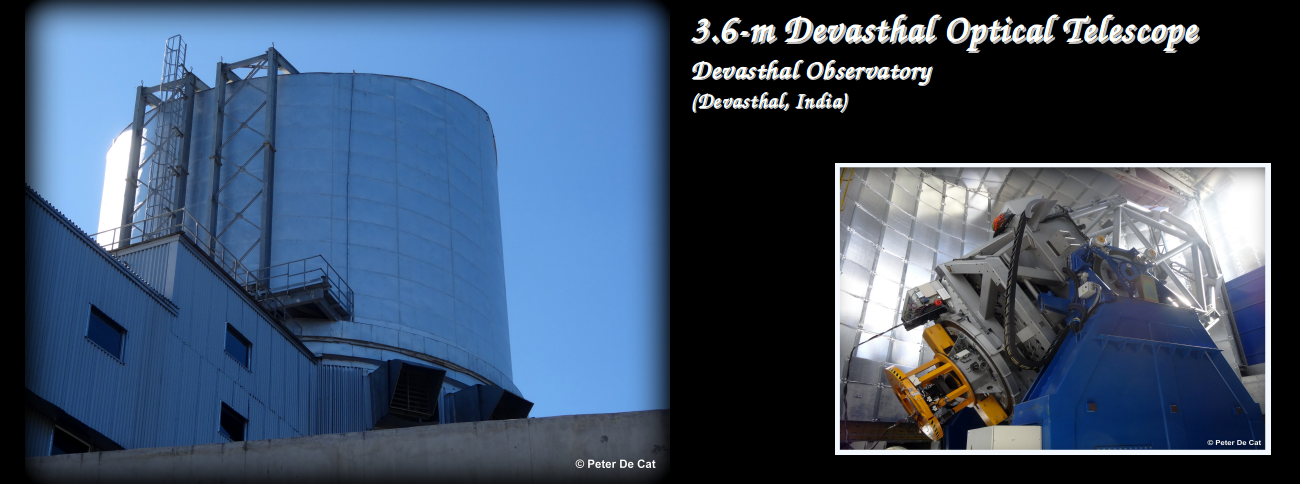3.6-m DOT @ ARIES

The 3.6-meter Devasthal Optical Telescope (DOT) in India is the largest optical telescope in the country and one of the most advanced
in Asia, located at Devasthal Observatory, Uttarakhand. Equipped with active optics technology, it provides high-resolution imaging
for deep-sky and time-domain astronomy. The telescope is capable of studying exoplanets, distant galaxies, and transient cosmic events.
Operated remotely, it supports international collaborations and enhances India’s role in global astronomical research.
The telescope was activated remotely on 31 March 2016 by Indian Prime Minister Narendra Modi and Belgian Prime Minister Charles Michel
from Brussels. The telescope optics were built in collaboration with the Belgian firm Advanced Mechanical and Optical System (AMOS).
(DOT website)
| # | Partner Institute | Location |
|---|---|---|
| 1 | ARIES | Aryabhatta Research Institute of Observational Sciences (Nainital, India) |
| 2 | DOT Consortium | Multi-national collaboration |
| 3 | ISRO | Indian Space Research Organisation (India) |
Location Details
| Location | Devashthal Observatory (Devashthal, India) |
|---|---|
| Coordinates | 29°21'42" North, 79°41'06" East |
| Altitude | 2450m |
| Type | Optical Ritchey–Chrétien telescope |
| Size | 3.6m (primary mirror) |
| Operated by | ARIES (Nainital, India) |
| Instruments | TIRCAM, Imager, SPIM (Photometry), ADFOSC, TANSPEC (Low resolution Spectroscopy) |
Telescope Time
Form: Online in Dopses
Submission: Online in Dopses
Requirement: 60% for Indian proposals, 33% for ARIES proposals, 7% for Belgian proposals
Observing Cycles
Cycle C1: 1 February - 31 May (proposal deadline: 1 December)
Cycle C2: 1 October - 31 January (proposal deadline: 1 August)
IMAGER
- Detector: 4096 x 4096 CCD camera
- Wavelengths: 400-900 nm
- Field-of-view: 6.5'x6.5'
- Filters (broad): SDSS u, g, r, i, z; Bessel U, B, V, R, I
- link to more info
TIRCAM2 (TIFR Near Infrared Imaging Camera - II)
- Wavelengths: 1.0-3.7 μm
- Field-of-view: 86.5"x86.5"
- Filters (broad): J, H, K
- Filters (narrow): BrG, K-cont, PHH, nB
- highlight of this camera is the observational capability for sources upto magnitudes of 9.2 in the narrow L-band (nbL; λcen∼ 3.59 microns)
- link to more details
ADFOSC (Aries-Devasthal Faint Object Spectrograph & Camera)
- Detector: 4096 x 4096 CCD camera
- Wavelengths: 350-1050 nm
- Field-of-view: 13.6'x13.6'
- Filters (broad): SDSS u, g, r, i, z
- Filters (narrow): (10.2 nm width) with central wavelengths at 491.6, 660.9, 674.3, and 683.3 nm
- Spectral resolution: 0.1-0.7 nm/pixel
- link to more details
TANSPEC (TIFR-ARIES Near Infrared Spectrometer)
- Detector: 2048 x 2048 H2RG
- Wavelengths: 550-2540 nm
- Field-of-view: 1'x1'
- Filters (broad): Y, J, H, K
- Filters (narrow): narrow-vband H2 and BrG
- Spectral resolution: R~2750 (cross-dispersed), R~100-350 (grism)
- link to more details
Side Port IMAGER
- Detector: 4096 x 4096 CCD camera
- Wavelengths: 400-900 nm
- Field-of-view: 6.5'x6.5'
- Filters (broad): SDSS u, g, r, i, z; Bessel U, B, V, R, I
- link to more details